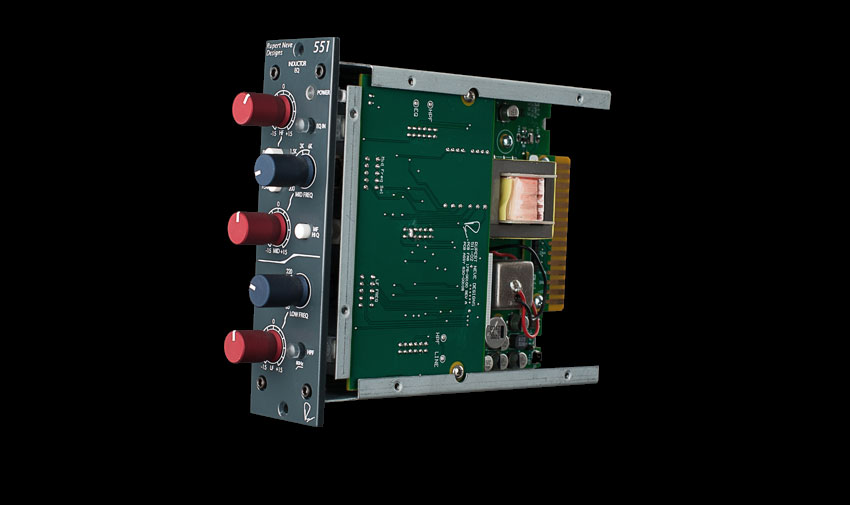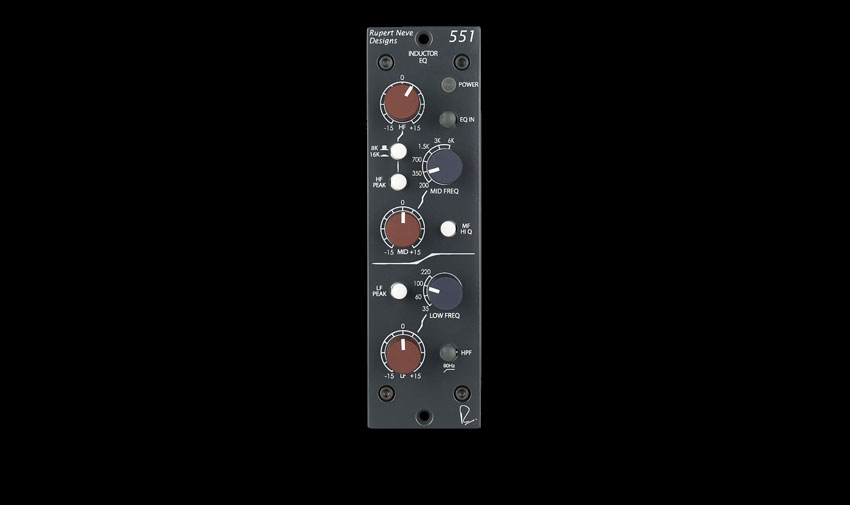NAMM 2014: RND unveils Rupert Neve-designed 500 Series EQ
Fancy a Neve EQ for under a grand?

RND 551 Inductor EQ

Controls
NAMM 2014: Good news for those of us lusting after Neve-style sounds, but without the readies to buy an iconic studio: Rupert Neve Designs has just announced the 551 Inductor EQ - the first Rupert Neve 500 series module to be designed by the man himself.
According to the press release, the 551 is a three-band EQ that draws on the classic Neve designs and RND says that it's paid "extreme attention to detail" towards the module's components and circuitry.
The 551 also reportedly features some capabilities beyond those of its desk-mounted ancestors, including the ability to use the low frequency band as a shelf or peak filter and enhanced control over the high frequencies.
What's perhaps most exciting to the home recordist is the price - the 551 is launching with an MSRP of $950. We'll reserve judgement until we hear it in action, but the prospect of an authentic-sounding Neve EQ for under a grand has just become a genuine possibility.
Read the full press release below to find out more and hear what Rupert Neve has to say about the module.
RND 551 Inductor EQ press release
At the 2014 NAMM show, Rupert Neve Designs is launching the 551 Inductor EQ: the first and only equalizer for the 500-Series actually designed by Rupert Neve. Featuring 3 bands of EQ inspired by Mr. Neve's most prized vintage designs, along with custom-wound inductors, transformers and class-A gain blocks, the 551 brings the thick, powerful lows and sweet highs of Rupert's classics to the 500-Series format.
The 551 echoes Rupert's classic 3-band EQ feature set, with a custom inductor, switched frequencies and a HPF. Traditional transformer-coupled inputs and outputs designed specifically for the 500 Series are used for both technical performance reasons and optimum musical reproduction. The 551 will begin shipping in late January 2014 with a US list price of $950.
Want all the hottest music and gear news, reviews, deals, features and more, direct to your inbox? Sign up here.
The 3-band, custom-tapped inductor EQ on the 551 was inspired by RND's favorite portions of Rupert's vintage EQ designs. The low frequency band is designed to produce a creamy, resonant bass response - however, unlike the vintage modules that inspired it, the LF band on the 551 can be used as either a shelf or a peak filter, adding punch, dimension, and control to your low end. The 551's inductor midrange band is ideal for sweetening vocals and instruments while bringing them forward in a mix, and its proportional "Q" response makes it well-suited for minimizing problematic frequencies.
The high frequency band is a hybrid vintage / modern design, blending inductor circuitry with capacitor-based topologies to achieve vintage tones with enhanced control. The High Pass filter is a 12dB/octave design with a fixed 80Hz frequency, and can be used in tandem with the low frequency EQ to add low-end presence without clouding the source material.
As Rupert originally intended with his most prized classic designs, each EQ section uses low-feedback, class-A discrete electronics to prevent low-level artifacts and harshness from detracting from the tonal shaping. However, the updated EQ circuit of the 551 is a decidedly modern design using techniques and components that were simply not available 35 years ago, and should not be considered a "clone".
Both the high and low band can be switched from shelf to peak curves and offer 15 dB of boost or cut. The high band can be switched from 8 kHz to 16 kHz, and the low band can be selected at 35 Hz, 60 Hz, 100 Hz or 220 Hz. The inductor based Mid Band offers 6 center frequencies; 200 Hz, 350 Hz, 700 Hz, 1.5 kHz, 3 kHz and 6 kHz. The Mid Band also has a "Mid Hi Q" switch to narrow the bandwidth (increase the Q) of the filter. This is an EQ with a truly vintage soul.
For RND founder Rupert Neve, the 551 represents a commitment to producing 500 series modules that don't compromise in quality,
"While creating functional 500-series modules is relatively simple, designing those modules to equal their non-500 series counterparts with the current, voltage and space restraints is quite challenging. In creating our own 500 Series Modules, we experimented with a number of different transformer and circuit designs to achieve the same presence and sweetness found in the Portico Series of modules.
"The result of these efforts is that outside of the slightly lowered headroom, our 500 series modules are nearly indistinguishable from standard Portico Series modules, and are perfectly suited for studios of the highest-caliber."
Another element unique to the 551, is the custom-wound inductor in the EQ circuitry. Inductors are wires wound around a coil that provide a form of frequency-dependant resistance. When they saturate, they bring out beautifully musical harmonics that give your tracks the smooth, polished sound that has made Rupert's consoles and equipment so desirable for over fifty years.
With an extreme attention to detail towards variables like the winding and core materials in relation to the surrounding EQ circuitry, the 551′s custom inductor helps the EQ capture the vitality of Rupert's vintage modules, while still retaining its own sonic signature.
Shipping for the 551 will begin in late January, 2014 with a US list price of $950.
About Rupert Neve Designs: Founded by Rupert and Evelyn Neve, Rupert Neve Designs is built on passion, experience and a desire to create products embodying the highest musical quality. In continuing his legacy as a pioneer in audio circuit design, Mr. Rupert Neve is currently focusing his talents on creating innovative solutions to the issues facing the modern recording engineer.
For further information on Rupert Neve Designs please visit www.rupertneve.com


Matt is a freelance journalist who has spent the last decade interviewing musicians for the likes of Total Guitar, Guitarist, Guitar World, MusicRadar, NME.com, DJ Mag and Electronic Sound. In 2020, he launched CreativeMoney.co.uk, which aims to share the ideas that make creative lifestyles more sustainable. He plays guitar, but should not be allowed near your delay pedals.
